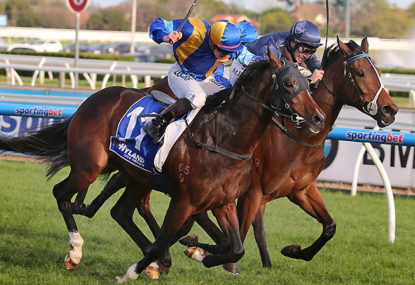We don’t often talk about racecourses on The Roar, but my favourite track to watch racing is Canterbury Racecourse in Sydney. I find the facilities comfortable and the track so tight that you don’t even need to watch the big screen or use binoculars to follow the horses during a race.
In fact, I love Canterbury so much I once wrote a small book on Canterbury Racecourse for a university assignment.
Canterbury, in my opinion, is one of the best racetracks in the country. First and foremost its drainage is outstanding. Unlike almost any other track in New South Wales, Canterbury can cope with a deluge of rain.
When the races would be abandoned at Rosehill or Warwick Farm, the track might only be rated slow or on the better side of heavy at Canterbury.
The tight-turning nature of the Canterbury track means it is one of the fairest tracks in the country. Jockeys are always keen to ensure they don’t end up racing wide at Canterbury, and with short straights and long turns, it adds up to fast-paced racing a lot of the time.
You would struggle to find a bigger advocate of fast-paced racing than myself.
When the pace is fast, the cream rises to the top and the last furlong becomes a slog. Generally the best horse will win a race that is run truly throughout.
Canterbury is by no means perfect. It can be very hard to win from the second half of the field, but I’d argue it’s no harder at Canterbury than what it is at Rosehill or Warwick Farm.
And there’s certainly a lot less track bias at Canterbury than what you’ll find at either Rosehill or ‘the Farm’.
So why is Canterbury the only ATC track that doesn’t host a Group race? Why do I keep reading newspaper articles hinting at racing administrators wanting to sell the Canterbury racetrack?
And why the heck is the Canterbury Stakes (1300m, Group 1, weight-for-age) being run at Randwick (for the first time) on Saturday?
Randwick doesn’t even run 1300m races very often. There hasn’t even been five races run at Randwick over 1300m this season.
Randwick already hosts a Group 1 sprint – the TJ Smith (1200m, Group 1, weight-for-age), which is being run this year on April 12. There is no need for the Canterbury to be run at Randwick.
I’d like to see the ATC move the Canterbury Stakes back to Canterbury next year. I think it should be run on a Friday night in early March.
Moonee Valley successfully hosts Group 1 meetings on Friday nights a few times each season in Melbourne, so the formula can definitely work.
For the race to be moved to Canterbury, the distance of the race will need to be moved back to 1280m, which is the maximum sprint trip at Canterbury. But a reduction in distance will certainly suit those horses who will use the race as their final TJ Smith lead-up.
Until six years ago, there was Group 1 racing at Canterbury almost each season. Many champions have raced at Canterbury.
Octagonal, on route to perhaps the most famous Triple Crown in Australian racing history, won the now defunct Canterbury Guineas (1900m, Group 1, three-year-olds), the old first leg of the Triple Crown, on the Canterbury track in 1995.
The great Manikato won the 1982 Canterbury Stakes at Canterbury. The first time dual-hemisphere champion So You Think was ever seen publicly was at Canterbury for a barrier trial, while the legendary Kingston Town’s first ever start was at Canterbury.
In 2004, I earmarked Wonderful World as a Group 1 horse after seeing him win on debut at Canterbury.
Ten months later he won the Caulfield Guineas (1600m, Group 1, three-year-olds). The following year, he ran second in the Cox Plate (2040m, Group 1, weight-for-age).
In March of 2010, I saw a horse called Once Were Wild completely dominate a lowly race from the front at Canterbury. I followed her to an Australian Oaks (2400m, Group 1, three-year-old fillies) victory six weeks later.
In September of 2012, my colleague at The Roar Andrew Hawkins had been spruiking a New Zealand horse called Dundeel.
So I hopped on a train to Canterbury and watched Dundeel fight his way to a nose victory on his Sydney debut. I immediately fell in love with his desire to win.
Five Group 1s later, It’s A Dundeel, as he is now known, is one of the most famous horses in the world.
Six months ago, I saw Eurozone win on debut at Canterbury, when quite simply, he had no right. I’m looking forward to seeing him win his first Group 1 at some point this year.
Canterbury is a great track. It has idiosyncrasies like ‘the Canterbury plug’, which most horses that race at the track will fall victim to.
The Canterbury plug is how my mates and I describe the last 100m of almost every race at Canterbury. Because the pressure of races at the track is usually so intense, almost every horse that races at Canterbury will plug home (instead of sprint) in the last 100m.
Even Dundeel plugged when he came to Canterbury! Very few horses defy the plug but those that do almost always go on to win Group races.
The last horse I saw defy the Canterbury plug was Eurozone. The next week, we were talking about him on The Roar before many racing fans knew he even existed. A few months later he won a Group 2.
I’m writing this article because I love Canterbury Racecourse. And I don’t like the future I’m seeing for it.
Canterbury deserves more than hosting midweek meetings. It deserves to host at least one genuinely good race.
I’m prepared to back in Canterbury to the point where I’d declare Canterbury would put on a good race if the ATC moved the Canterbury Stakes back to its rightful home.
The Canterbury at Randwick? It’s just not racing!





























































































